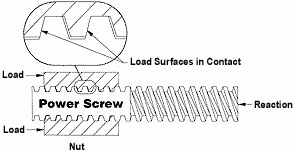Power Screws Basics
Power screws cover a wide variety of screw series and include Acmes, Hi-leads®, Torqsplines® and other special series (not offered in this catalog but produced for OEM customers) such as Stub Acme, Trapezoidal (“metric Acme”) and Buttress. Regardless of the thread series, an externally threaded screw mates with an internally threaded nut of the same thread form; when either member rotates, the other member translates. Contact between the screw and nut is sliding friction at the screw and nut interface surface (Figure 19).
Efficiencies vary from:
- 20% – 30% for standard Acmes
- 25% – 40% for Hi-leads®
- and up to 75% for some Torqsplines®.
Efficiency of any power screw and nut is dependent upon the coefficient of friction between the screw and nut materials, the lead angle and the pressure angle of the screw thread. Of these, the lead angle has the greatest effect, the coefficient of friction has a secondary effect and the pressure angle has a minimal effect. For the exact formula of efficiency as a function of these variables, see the Useful Formulas section.
Efficiencies of power screws may vary with load. When the load increases, unit pressure increases and the coefficient of friction can drop. This is especially true for plastic nuts but has also been observed with bronze nuts. Power screws in the Acme screw series (single start screws) are self-locking. This means that they can sustain loads without the use of holding brakes. In vibrating environments, some locking means may be needed, but Acme screws rarely require brakes. This makes them simple and inexpensive for use in many different applications such as machine tools, clamping mechanisms, farm machinery, medical equipment, aerospace and other mechanisms of many industries.
Materials to Make Power Screws
Power screws are typically made from carbon steel, alloy steel, or stainless steel and they are usually used with bronze, plastic, or steel mating nuts. Bronze and plastic nuts are popular for higher duty applications and they provide low coefficients of friction for minimizing drive torques. Steel nuts are used for only occasional adjustment and limited duty so as to avoid galling of like materials. For more information about using steel Acme nuts, see Roton Engineering Bulletin No. 971.

FIGURE 19